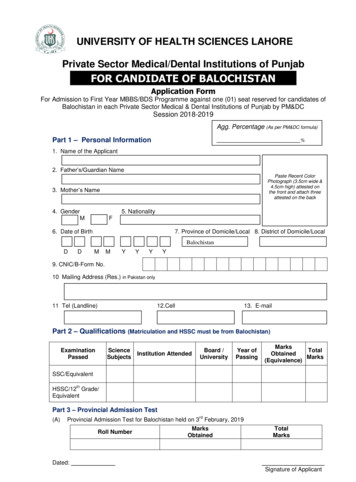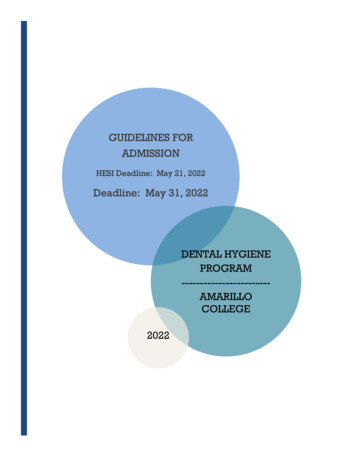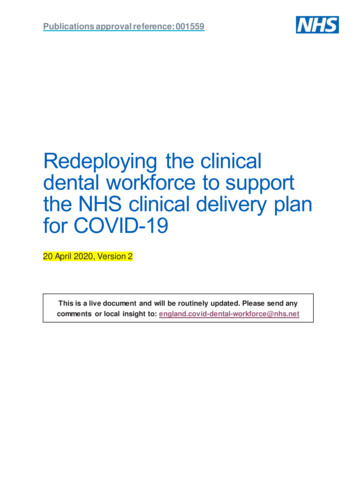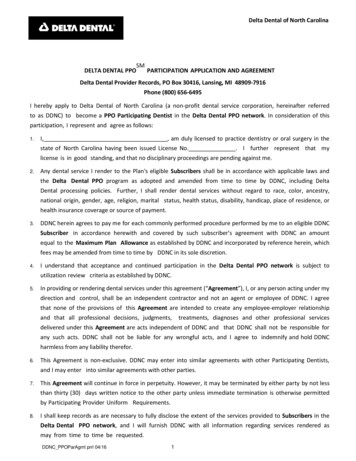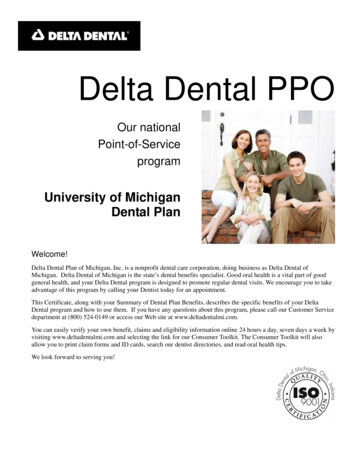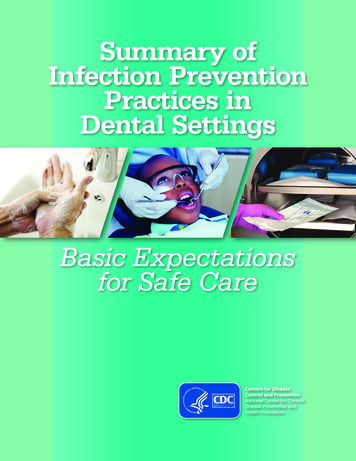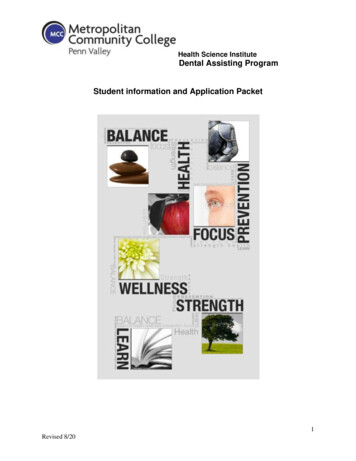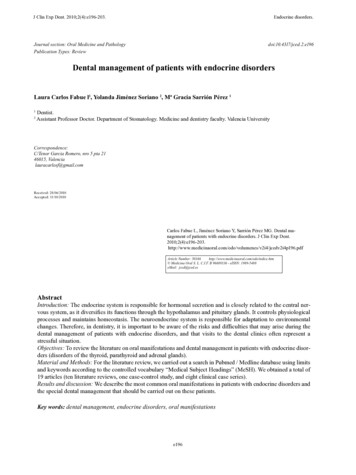
Transcription
J Clin Exp Dent. 2010;2(4):e196-203.Endocrine disorders.doi:10.4317/jced.2.e196Journal section: Oral Medicine and PathologyPublication Types: ReviewDental management of patients with endocrine disordersLaura Carlos Fabue l1, Yolanda Jiménez Soriano 2, Mª Gracia Sarrión Pérez 112Dentist.Assistant Professor Doctor. Department of Stomatology. Medicine and dentistry faculty. Valencia UniversityCorrespondence:C/Tenor Garcia Romero, nro 5 pta 2146015, Valencialauracarlosf@gmail.comReceived: 28/06/2010Accepted: 11/10/2010Carlos Fabue L, Jiménez Soriano Y, Sarrión Pérez MG. Dental management of patients with endocrine disorders. J Clin Exp m/odo/volumenes/v2i4/jcedv2i4p196.pdfArticle Number: 50346http://www.medicinaoral.com/odo/indice.htm Medicina Oral S. L. C.I.F. B 96689336 - eISSN: 1989-5488eMail: jced@jced.esAbstractIntroduction: The endocrine system is responsible for hormonal secretion and is closely related to the central nervous system, as it diversifies its functions through the hypothalamus and pituitary glands. It controls physiologicalprocesses and maintains homeostasis. The neuroendocrine system is responsible for adaptation to environmentalchanges. Therefore, in dentistry, it is important to be aware of the risks and difficulties that may arise during thedental management of patients with endocrine disorders, and that visits to the dental clinics often represent astressful situation.Objectives: To review the literature on oral manifestations and dental management in patients with endocrine disorders (disorders of the thyroid, parathyroid and adrenal glands).Material and Methods: For the literature review, we carried out a search in Pubmed / Medline database using limitsand keywords according to the controlled vocabulary “Medical Subject Headings” (MeSH). We obtained a total of19 articles (ten literature reviews, one case-control study, and eight clinical case series).Results and discussion: We describe the most common oral manifestations in patients with endocrine disorders andthe special dental management that should be carried out on these patients.Key words: dental management, endocrine disorders, oral manifestationse196
J Clin Exp Dent. 2010;2(4):e196-203.IntroductionThe endocrine system is responsible for hormonal secretion and is closely related to the central nervous system,as it diversifies its functions through the hypothalamusand pituitary. It controls physiological processes andmaintains homeostasis. The neuroendocrine system isresponsible for adaptation to environmental changes.Also, a function of the nervous system is to provide acorrect organic response. Its response may be primary,with the release of neurotransmitters, or if the stimulusprevails, the endocrine system secretes hormones. Thisis especially important in dentistry because many of thepatients attending the dental clinics face stressful situations (1). Awareness is therefore necessary of the risksand difficulties that may arise during the dental management of patients with endocrine disorders and the mostcommon oral manifestations.ObjetivesThe aim of this article was to perform a literature reviewabout:1. Oral manifestations in patients with endocrine disorders (disorders of the thyroid, parathyroid andadrenal glands).2. Dental management of patients with endocrinedisorders (disorders of the thyroid, parathyroid andadrenal glands).Materials and methodsFor the literature review, we carried out a literaturesearch in Pubmed / Medline database using the followingwords according to the controlled vocabulary (MeSH):“dental management”, “oral manifestations”, “hyperthyroidism”, “hypothyroidism”, “hyperparathyroidism”“primary hyperparathyroidism”, “secondary hyperparathyroidism”, “hypoparathyroidism”, “Addison’s disease”, “primary adrenocortical insufficiency”, “Cushing’ssyndrome”, “adrenocortical hyperfunction”. The limitsused for the search were: articles in English or Spanishand articles published within the last 10 years. We reviewed a total of 19 articles of which ten were literaturereviews, one case-control study and eight clinical caseEndocrine disorders.series.ResultsOral manifestations and dental management of patientswith thyroid gland disordersThe thyroid gland secretes three hormones: thyroxine(T4), triiodothyronine (T3) and calcitonin. T4 and T3are hormones that affect metabolic processes throughout the body and are involved in oxygen use. Thyroidstimulating hormone (TSH or thyrotropin), producedby the pituitary gland, regulates the secretion of thyroidhormones (T4 and T3) through a negative feedbackmechanism. Calcitonin is involved, with parathyroidhormone and vitamin D, in regulating serum calciumand phosphorus levels and in the skeletal remodeling.Thyroid hormones influence the growth and maturationof tissues, energy metabolism and turnover of both cellsand nutrients (2,3). HyperthyroidismHyperthyroidism or thyrotoxicosis is defined by a decrease in thyroid hormone production and thyroid glandfunction. It is caused by ectopic thyroid tissue, toxicthyroid adenoma, toxic multinodular goiter, subacutethyroiditis, factitious thyrotoxicosis and Graves’ diseaseand diffuse toxic goiter, being the most common causeof hyperthyroidism (2,4).Hyperthyroidism can have clinical manifestations atgastrointestinal levels (weight loss, increased appetite,nausea and vomiting), in hair, skin and nails (thin andbrittle hair, soft nails, warm and moist skin, increasedskin pigmentation and heat intolerance). In the hands(palmar erythema, fine tremor, sweating and clubbing).At neuromuscular levels (fatigue, atrophy, weakness,muscle fatigue and pain). At cardiovascular levels (tachycardia, palpitations, systolic hypertension and dyspnea). At psychological levels (anxiety, nervousness,irritability, insomnia, impaired concentration and reduced stress threshold) and in ocular level (bilateral exophthalmos, ptosis, periorbital edema, retraction of theupper and lower eyelid due to muscle contracture andconjunctival injection) (2,4).We find oral manifestations such as (2,3) (Table 1):ORAL MANIFESTATIONS OF PATIENTS WITH THYROID GLAND DISORDERSHYPERTHYROIDISMHYPOTHYROIDISM1. Accelerated dental eruption in children1. Delayed eruption2. Maxillary or mandibular osteoporosis2. Enamel hypoplasia in both dentitions, (being less3. Enlargement of extraglandular thyroid tissue intense in the permanent dentition)(mainly in the lateral posterior tongue)3. Anterior open bite4. Increased susceptibility to caries4. Macroglossia5. Periodontal disease5. Micrognathia6. Burning mouth syndrome6. Thick lips7. Development of connective-tissue diseases like 7. DysgeusiaSjögren’s syndrom or systemic lupus erythematosus 8. Mouth breathingTable 1. Oral manifestations of patients with thyroid gland disorders.e197
J Clin Exp Dent. 2010;2(4):e196-203.accelerated dental eruption in children, maxillary ormandibular osteoporosis, enlargement of extraglandular thyroid tissue (mainly in lateral posterior tongue),increased susceptibility to caries and periodontal disease(possibly because these patients feel the need to consume higher quantities of sugar to meet their physical requirements), burning mouth syndrome and developmentof connective-tissue diseases such as Sjögren’s syndrome or systemic lupus erythematosus.Treatment of patients with thyrotoxicosis may involveantithyroid agents (propylthiouracil, carbimazole, andmethimazole) which block hormone synthesis; iopanoicacid and ipodate sodium that are inhibitors of the peripheral conversion of T4 to T3; beta-blockers (propanolol) that slow the adrenergic activity and eliminate thetachycardia, anxiety, nervousness, tremors and sweating; glucocorticosteroids, such as dexamethasone, thatdecrease the secretion of thyroid hormone and iodinethat inhibits the release of preformed hormone (2,4). Dental management of the patient with hyperthyroidismBefore dental treatment is planned, we must carry out adetailed general clinical history, and a consultation withthe specialist is recommended, to discuss the overallcondition of the patient. At the time of the treatment wemust consider several aspects:1. In controlled patients, we will carry out the same dental management as in healthy patients. We must avoidsevere stress situations and the spread of infectiousfoci (3).2. In uncontrolled cases, we must take the same precautionary measures as in controlled patients. We mustrestrict the use of epinephrine or other pressor aminesin local anesthetics of the retraction cords because themyocardium of these patients is sensitive to adrenaline and may unleash arrhythmias, palpitations andchest pain (2,3,5). We must avoid surgical proceduresbecause surgery, presence of acute oral infection andsevere stress may precipitate thyroid storm crisis. Ifan emergency dental treatment is required, consultation with the patient’s endocrinologist is advisable because a conservative treatment is often preferable. Treatment should be discontinued if signs orsymptoms of a thyrotoxic crisis develop, and accessto emergency medical services should be available.These symptoms include tachycardia, irregular pulse,sweating, hypertension, tremor, nausea, vomiting, abdominal pain and coma (2,3).3. People who have hyperthyroidism and are treatedwith propylthiouracil must be monitored for possibleagranulocytosis, hypoproteinemia or bleeding, anda complete blood count including prothrombin timebefore performing any invasive procedures is usuallyrecommended (3).4. These patients are susceptible to central nervous sys-Endocrine disorders.tem depressant drugs such as barbiturates (3).5. In these patients proper analgesia is indicated andnonsteroidal anti-inflammatory drugs (NSAIDs) andaspirin should be used with caution (3). HypothyroidismHypothyroidism is defined by a deficiency of the thyroidhormone. It can be acquired or by congenital defects.When it is present in infancy, it is manifested as cretinism and if it occurs in adults (especially in middle-agedwomen) it is known as myxedema (3,4,6,7).Characteristic signs of cretinism include mental retardation, developmental and growth delay, marked disproportion between the head and body (wide head), lackof muscle tone, overweight, less expressive face with abroad and flat nose, hypertelorism, short neck and thick,pale, dry and wrinkled skin. Myxedema is characterized by widespread metabolic slow-down, depression,overweight, diminished cardiac output and respiratoryrate, decreased pulse, generalized edema (especially inface and extremities), hoarseness because the edemaaffects to vocal cords, sinus bradycardia, swollen nose,ears and lips, thickened and dry skin, scalp brittleness,thin or absent eyebrows and decreased sweating. Generalized edema can affect the tongue causing difficultyspeaking and swallowing and serrated tongue (3,4,6,7).Common oral findings in hypothyroidism include (3)(Table 1): delayed tooth eruption, enamel hypoplasia inboth dentitions, being less intense in the permanent dentition, micrognathia, open bite due to lack of condylarand mandibular growth, macroglossia, thick lips, dysgeusia and mouth breathing.Patients with hypothyroidism are treated with syntheticpreparations containing sodium liothyronine, sodium levothyroixin or 1-throixine. (3,7).Hormone replacement therapy based on thyroid hormones can be prescribed in cases of severe deficiency ofthyroid hormones. Dental management of the patient with hypothyroidismConsulting the patients’ physician and carrying out a detailed general clinical history before performing dentaltreatment is indicated (3,7).1. In controlled patients we must avoid oral infection(3,7).2. In uncontrolled patients, oral infection, central nervous depressants such as narcotics and barbituratesshould be avoided because they may cause an exaggerated response. In controlled patients, these drugsshould be used sparingly, with a reduced dosage. Thepresence of oral infection, central nervous depressantsand surgical procedures can precipitate a myxedematous coma. Surgery procedures should also be avoided in these patients. Myxedematous coma includeshypothermia, bradycardia, severe hypotension andepileptic seizure. If that happens, dental treatmente198
J Clin Exp Dent. 2010;2(4):e196-203.should be discontinued and access to emergency medical services should be available (3,7).3. Drug interactions of 1-thyroxine include (3):- Metabolism increase using phenytoin, rifampin andcarbamazepine.- Absorption is impaired when iron sulfate, sucralfateand aluminum hydroxide are used.- Concomitant use of tricyclic antidepressants elevates 1-thyroxine levels.4. These patients are susceptible to cardiovascular disease, therefore they may be on anticoagulation therapy. Before dental treatment is carried out, a complete blood count is required to evaluate coagulationfactors. We must avoid the use of epinephrine in localanesthetics or retraction cords. Antibiotic prophylaxismust be assessed in valvular pathology and atrial fibrillation (3).Oral manifestations and dental management of patientswith parathyroid glands disordersParathyroid glands secret parathyroid hormone (PTH)involved in regulating the metabolism of calcium andphosphorus. PTH plays an important role in tooth development and bone mineralization and increases bone resorption. In the kidneys, it stimulates formation of activemetabolite of vitamin D, which promotes the intestinalabsorption of calcium and decreases renal reabsorptionof phosphate. HyperparathyroidismHyperparathyroidism (HPT) is characterized by hypersecretion of parathyroid hormone which occurs in threecategories (8-11):- Primary: occurs with a hyperfunction of one or moreparathyroids, usually caused by a tumour (adenoma in85% of all cases) or hyperplasia of the gland that produces an increase in PTH secretion resulting in hypercalcemia and hypophosthamia.- Secondary: normally related to patients with intestinalmalabsorption syndrome or chronic renal failure, oc-Endocrine disorders.curring in a decrease of vitamin D production or withhypocalcemia causing the glands to produce a highquantity of PTH. There is also hyperphosphatemia.The PTH-related signs are brown tumors and osteitisfibrosa cystica, which is referred as renal osteodystrophy or Von Recklinghausen’s disease.- Tertiary: is an uncommon condition, affecting up to 8% of patients with secondary HPT after a successfulrenal transplant. It occurs when the parathyroids activity becomes autonomous and excessive, leading tohypercalcemia (8).The diagnosis of HPT is suspected by an increase inserum calcium and it is confirmed by the increase in PTH(12). One of the main clinical manifestations of hyperparathyroidism is bone disease. The ribs, clavicles, pelvic girdle and mandible are the bones most involved (9).In the oral cavity, the most common clinical manifestations of HPT are brown tumor, loss of bone density,weak teeth, malocclusions, soft tissue calcificationsand dental abnormalities such development defects,alterations in dental eruption and widened pulp chambers (9) (Table 2).Brown tumor presents itself as a friable red-brownmass. Its name is due to color that it takes from thehaemorrhagic infiltrates and haemosiderin depositsthat are often found inside. Brown tumor presents asosteolytic lesion that develops due to changes in bonemetabolism caused by high serum concentration ofPTH. It is mainly due to secondary HPT in patientswith renal insufficiency, but it has also been describedas a rare manifestation of calcium malabsorption andsome forms of osteomalacia. Nowadays, brown tumoris an extremely rare manifestation of primary HPT; inthese cases it is usually a result of the overproductionof the parathyroid hormone by a parathyroid tumor(single adenoma, 2 or more adenomas or carcinoma).Mandible involvement is common, especially in thearea of premolars and molars, and it is rare in maxilla.ORAL MANIFESTATIONS OF PATIENTS WITH PARATHYROID GLAND DISORDERSHYPERPARATHYROIDISMHYPOPARATHYROIDISM1. Dental abnormalities:1. Dental abnormalities:- Widened pulp chambers- Enamel hypoplasia in horizontal lines- Development defects- Poorly calcified dentin- Alterations in dental eruption- Widened pulp chambers- Weak teeth- Dental pulp calcifications- Maloclussions- Shortened roots2. Brown tumor- Hypodontia3. Loss of bone density- Delay or cessation of dental develop4. Soft tissue calcificationsment2. Mandibular tori3. Chronic candidiasis4. Paresthesia of the tongue or lips5. Alteration in facial musclesTable 2. Oral manifestations of patient with parathyroid gland disorders.e199
J Clin Exp Dent. 2010;2(4):e196-203.Radiographically, lesions are characterized as well-defined radiolucent areas, uni or multilocular. As characteristic radiographic findings we can find a widespreadloss of the lamina dura, and changes in the pattern ofthe trabecular bone of the jaws. Long-term injurescommonly produce a significant expansion of cortical,root resorption and displacement of roots can appear.Histologically, it is characterized by an abundant estroma, consisting of bundles of spindle or oval cells,and several multinucleated osteoclast-like giant cells.Calcified material can be found, as well as areas withextravastion of red blood cells and pigmentation byhaemosiderin. These findings are not pathognomonic,making it necessary to perform a differential diagnosis with other lesions such as an aneurismal bone cyst,cherubism and central giant cell granuloma; being thepresence of this lesion together with a history of HPTwhich confirms the diagnosis of brown tumor. Thetreatment of HPT is the first step in the managementof the brown tumor, as spontaneous regression of thelesion often occurs. However, several cases of browntumor that did not disappear or even grew after normalization of HPT level have been reported. In thesecases brown tumor resection should be the preferredtreatment (8,9,13-15). Dental management of the patient with hyperparathyroidismThe clinical management of these patients does not require any special consideration. We should know thatthere is a higher risk of bone fracture, so we must takeprecaution in surgical treatments. On the other hand, itis important to recognize the presence of brown tumourand to perform a correct differential diagnosis so as notto conduct an inadequate treatment. HypoparathyroidismHypoparathyroidism is a metabolic disorder characterized by hypocalcemia and hypophosphatemia due to adeficiency or absence of parathyroid hormone secretion.It may also develop as an isolated entity of unknownetiology (idiopathic hypoparathyroidism), or in combination with other disorders such as autoimmune diseasesor developmental defects (16).Hypoparathyroidism can cause hypocalcemia with consequent paresthesias, tetany and seizures. Disorders ofectodermal tissues are also common in these patients.These disorders include alopecia, scaling of the skin, deformities of the nails and dental abnormalities such asenamel hypoplasia in horizontal lines, poorly calcifieddentin, widened pulp chambers, dental pulp calcifications, shortened roots , hypodontia and mandibular torias PTH affects rate of eruption, formation of the matrixand calcification. A delay or cessation of dental growthand development, chronic candidiasis of the oral mucosaand nail, paresthesia of the tongue or lips and alterationof the facial muscles can occur (16) (Table 2).Endocrine disorders.This pathology is diagnosed on the basis of measurements of serum calcium and parathyroid hormone levels. The main treatments available for these patients isvitamin D or its analogues, calcium salts and drugs thatincrease renal tubular resorption of calcium, to obtainadequate, but low, normal serum calcium levels (16). Dental management of the patient with hypoparathyroidismThese patients have more susceptibility to caries because of dental anomalies. Dental management will be theprevention of caries with periodic reviews, advice regarding diet and oral hygiene instructions. Before performing dental treatment, serum calcium levels should bedetermined. They must be above 8mg/100ml to preventcardiac arrhythmias, seizures, laryngospasms or bronchospasms.Oral manifestations and dental management of the patient with adrenal glands disordersThe adrenal glands are located on the upper pole of eachkidney. They are composed of an internal or core portion (the adrenal medulla), which produce adrenaline,noradrenaline, dopamine and progesterone; and an outerportion or cortex, which is in turn responsible for theproduction of steroid hormones, such as: glucocorticoids(cortisol and cortisone), mineralocorticoids (aldosteroneand 18-deoxycorticosterone), and androgens (dehydroepiandrosterone). The cortex has three layers: glomerularor external, where mineralocorticoids are released, thefascicular or intermediate, where glucocorticoids areproduced and reticular or internal where androgens aresecreted (1).Regarding the role of substances that are secreted by thecortex, cortisol is involved in the mechanisms of adaptation of the organism to stress maintaining homeostasis;it has anti-inflammatory and immunosuppressive effect,it is responsible for mobilizing fatty acids from adiposetissue, it maintains vascular reactivity, it promotes theliver’s protein synthesis via neoglycogenesis, it increases gycemia, it inhibits bone formation and delays healing.Corticosteroid production and release from the adrenalcortex is in turn regulated by adrenocorticotropic hormone (ACTH), which is synthesized and secreted in theanterior hypophysis (adenohypophysis). In accordanceto the circulating glucocorticoid concentrations, a selfregulating or negative feedback mechanism is established at hypothalamic and hypophyseal level. ACTH isin turn controlled by a series of factors such as corticotropin release hormone (CRH), which is secreted by thehypothalamus, and by circadian rhythms (waking-sleepcycle), with cyclic variations in the plasma cortisol concentrations in the course of the 24-hour day, being maximum early in the morning and minimum at evening. Basal cortisol secretion in turn gradually increases with age,and an association moreover exists between high basale200
J Clin Exp Dent. 2010;2(4):e196-203.cortisol concentrations and a reduction in specific cognitive functions. Aldosterone is necessary for maintainingsodium and extracellular fluid balance, resulting in resorption of sodium in exchange with the potasium andhydrogen ions in the distal tubule of the nephron and inother tissues such as salivary glands and colon. It makesup to renin-angiotensin-aldosterone axis. Kidneys, inresponse to low blood volume, real or perceived (heartfailure), secrete an enzyme called rennin, which acts inthe general circulation on angiotensinogen produced bythe liver and converts it into angiotensin I. AngiotensinI, under the action of the angiotensin converting enzyme(ACE), converts it in angiotensin II. Angiotensin II isa potent arteriolar vasoconstrictor and the primary regulator of aldosterone secretion, which maintains bloodvolume by retaining sodium (1). Addison’s DiseaseIn Addison’s disease or primary adrenal insufficiencyexists a deficiency in the secretion of glucocorticoid andmineralocorticoid hormones by the adrenal cortex. It isassociated with idiopathic, surgical, or infectious destruction or tumor of parenchyma of the adrenal gland orinfiltration of the cortex by sarcoidosis, tuberculosis oramyloidosis (1).Cortisol deficiency clinically manifests as hypoglycemia, hypotension, asthenia, muscle weakness, anorexia,nausea, weight loss and diminished resistance to infections and stress.Characteristic melanic pigmentation may develop as aconsequence of cessation of inhibition at hypophyseallevel, with simultaneous increments of both ACTH andmelanocyte stimulating hormone (MSH). When this happens, the skin darkens in regions such as the elbows,folds of the hands or areolas of the breasts. The oral mucosa can in turn develop black-bluish plaques, mainlyaffecting buccal mucosa but it can also be seen on thegums, palate, tongue and lips. The lack of aldosteroneleads to sodium and liquid depletion with increased diuresis and secondary dehydration and hypotension (1). Dental management of the patient with Addison’sdiseaseMost of these patients are treated with corticosteroids.We can distinguish different stages of adrenal suppression, where we can find the patient undergoing corticosteroid therapy (1):- Stage I: doses of corticosteroids do not produce adrenalsuppression.- Stage II: the glucocorticois in blood inhibit the hypotalamic-hypophyseal-adrenal axis, and the bodystops producing cortisol physiologically. This stage istherefore characterized by adrenocortical suppression,though the administered corticoid dose is still insufficient to cover the organic needs in the event of stressinducing situations.- Stage III: the administered corticoid dose is sufficiente201Endocrine disorders.ly high to continue suppressing the adrenal cortex butalso to cover the body needs in the event of stress.This is interesting when we perform dental treatmentbecause according to the stage in which the patient is,supplementation of corticosteroids may or not be necessary (1, 17):- Patients with low-dose corticotherapy (LDC) ( 30mgof hydrocortisone/day):1. Patients with a history of regular corticoid use: nosupplementing is required either for routine procedures, nor surgical treatments because with thisdose of corticosteroid, adrenal suppresion does notoccur.2. Patients presently using corticoids: no supplementing required.- Patients with high-dose corticotherapy (HDC) ( 40mg of hydrocortisone/day):1. Patient with a history of regular use of HDC forshort periods (less than one month): the adrenal suppression is transient, recovering the stressresponse within 14 days after cessation of steroids. Therefore, for routine dental procedures,surgical procedures, very extensive treatmentsand in highly anxious patients we must consider:Those who have discontinued corticosteroidtreatment less than 14 days ago will require adaily maintenance dose on the day of treatment.If more than 14 days: no supplementing will berequired.2. Patients with a history of regular use of HDC formore than one month: no established regimen.3. Patients presently using HDC for one month ormore: no supplementing required.- Patients presently using 30-40 mg of hydrocortisone/day:If the patient is highly anxious or lengthy dentaltreatment or surgery procedure is to be performed, wemust double the daily dose on the day of treatment. Ifpostoperative pain is expected, we should also doublethe daily dose on the first postoperative day.- Patients receiving corticotherapy on alternate days forat least 30 days:On the non-corticoid days, no supplementing is required. Conservative management is indicated on therest of the days.- Patients with topical or inhaled steroids: no supplementing required.Other aspects of dental management of these patients are(1):1.Conducting treatment in the morning.2. Control of anxiety and emotional stress.3. Use long-acting anesthetics.4. Treatment of postoperative pain.5. Prevention of iatrogenic fracture during surgery in patients with a long history of continuous corticotherapy,
J Clin Exp Dent. 2010;2(4):e196-203.because glucocorticoids can increase the risk of fractureby causing osteoporosis.6. Consideration is also required of the possible interactions of glucocorticoids with a other drugs:- Phenytoin, barbiturates and rifampicin accelerate glucocorticoid metabolism.- Prednisone bioavailability decreases with the administration of antacids.- Glucocorticoids increase the requirements of insuline,oral antidiabetic drugs and hypotensive medication. Addisonian CrisesAddisonian crises or acute adrenococortical insufficiency is a rare but serious complication in patients withprimary Addison’s disease. Although, actually it is morelikely to be attributable to secondary adrenal failure(administration of high-doses of exogenous corticosteroids therapeutically) than to Addison’s disease. Thereason for this is the sudden withdrawal of exogenouscorticoids, or the existence of situations requiring greater amounts of corticoids than those afforded by replacement therapy. It presents as a sudden failure of theadrenal cortex function. The resulting clinical picturecompromises shock with nausea, vomiting, abdominalpain and hypotension. Fever and hypothermia may beobserved and can lead to coma and death (1). Dental management of the patient with AddisoniancrisesPrevention is the best management approach for Addisonian crises. We should perform a detailed clinical historyand a consultation with the specialist is recommended,and we take action accordingly. However, if crisis takesplace, we should interrupt dental procedure, place thepatient in dorsal decubitus and contact with the corresponding medical emergency service. Until medical helparrives, the patient should be administered oxygen (5-10liters/min). If the patient is unconscious, he should beplaced in dorsal decubitus with the legs raised, and weshould notify the emergency service to arrange transferof the patient to the hospital. Before four minutes haveelapsed, basic vital support should be provided in accordance to the patient’s condition. If an adrenal causeis suspected, 100 mg of hydrocortisone should be administered intravenously or intramuscularly, within 30seconds if possible, and two hours later, another 100 mgof hydrocortisone dissolved in saline for intravenous orintramuscular injection should be provided (1). Hyperadrenocorticism (Cushing’s syndrome)Cushing’s syndrome (CS) refers to manifestations induced by chronic exposure to excess glucocorticoidsproduced by the adrenal cortex. This excess can be caused by various reasons. It most commonly arises fromiatrogenic causes (due to administration of exogenousglucocorticoids). The second most comm
Dental management of the patient with hypothyroi-dism Consulting the patients' physician and carrying out a de-tailed general clinical history before performing dental treatment is indicated (3,7). 1. In controlled patients we must avoid oral infection (3,7). 2. In uncontrolled patients, oral infection, central ner-


